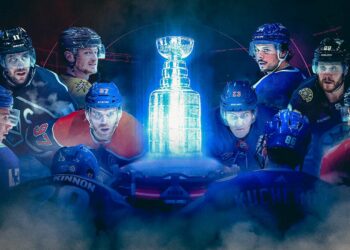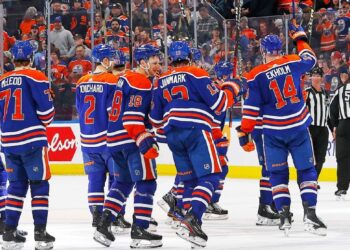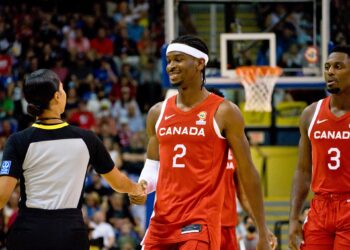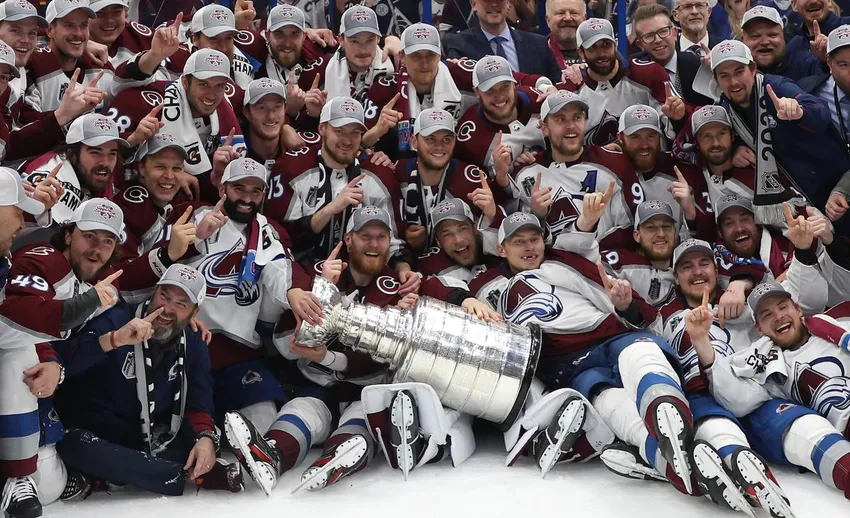By: Greg Rector
In the “Cold War on Ice,” in September 1972, an 8-game series of hockey games were played between the Soviet Union and Canadian-born NHL players. This series is etched in the memories of Canadians who witnessed the mighty Soviet Union hockey team and some of the best professional players from Canada for the first time ever. For me, it is still very vivid as in an unusual circumstance instead of my military father being posted to a new base in the summer he was posted in September. That comes into play later on. The first four games were played in Canadian cities and the final four games were played in the Soviet Union. The series is known as “The Summit Series.”
Team Canada's Paul Henderson (19), Bobby Clarke (28), Ron Ellis (6) & Bill White (17) celebrate a goal vs the Soviet Union in the 1972 Summit Series at the Luzhniki Ice Palace in Moscow, Russia. (Photo Bruce Bennett Studios) @BonsieTweets @Liams_Hockey @smorrisonmedia @Johnubacon pic.twitter.com/kVR9TSSiha
— Team Canada 1972 (@TeamCanada1972) March 31, 2022
These were the days before helmets became completely mandatory and you could still buy hockey sticks without a curve (Oh yeah only wood no composites like today) As well the NHL players certainly didn’t do much off-season training, unlike the Soviets who were training almost all year long. So an all-star group of Canadian NHL players led by the likes of Hall of Fame brothers Phil and Tony Esposito, Bobby Clarke ( Pre-Broad Street Bullies), and many other stars prepared to face the Soviets who were relatively unknown over here but who had dominated amateur hockey at the World Championships and Olympics for over a decade. This was the genesis of the tournament. Just as today try telling a Canadian they aren’t the best in the world in the game of hockey and you’ve insulted him or her to their very core. Add in the fact this was the height of the “Cold War,” and the stage has been set for the series.
Missing in Action
Team Canada would be without many big names for this tournament as 1972 saw the start of the upstart World Hockey Association. The WHA lured away players like Bobby “The Golden Jet,” Hull, Derek Sanderson, goaltender Gerry Cheevers, and many others. These players were excluded as the tournament was only for the NHL players. The biggest name of all in the game at the time defenseman Bobby Orr was also not available because of knee surgery.
The Canadian Games
The series would begin at the shrine of the sport, the fabled Montreal Forum the home of the most fabled franchise in the NHL the Montreal Canadiens, winners of the previous Stanley Cup. Team Canada would start Ken Dryden who had been the goalie for the Cup-winning Canadiens the previous spring after only playing 6 NHL regular season games, Dryden won the Conn Smythe Trophy as the MVP of the Stanley Cup finals. He was also a monster for that era standing 6’4″ and over 200lbs. Team Canada. As for the Soviet Union, they were all unknown to Canadians. That would change very quickly. Team Canada was hammered 7 to 3 by the Soviets and a nation was stunned. The Soviets played a very different style, skated majestically, passed and passed the puck repeatedly until they found an opening, and could they shoot the puck. Very quickly the names Alexander Yakushev, Valeri Kharlamov, and goaltender Vladislav Tretiak were being attempted to be pronounced all over Canada. Game two would be played in Toronto and Canada seemed to rebound in a rougher game by winning 4-1. It was on to Winnipeg for game three and the Soviets showed they could be equally as nasty with their sticks (International play fighting was a big no-no even back then) and the two teams played to a 4-4 tie. The final game on home soil was in Vancouver and the Soviet Union won 5-3. Canadian fans roundly booed Team Canada. Suddenly there was a foe that the Canadians seemed to have no answers for. This is where the days of playing yourself into shape at training camp began to come to an end. The Canadians clearly had underestimated these “amateurs,” from the Soviet Union (Never mind almost all of them were in the Red Army and played year round) Phil Esposito would vow a better effort in two weeks’ time when the series would resume in Moscow.
The Soviet Games
Two weeks later the two teams would resume hostilities and despite the time to prepare the Soviets would win game five 5 to 4. Game six was a very rough affair and Bobby Clarke lost his composure and went after Valeri Kharlamov’s ankle with a vicious swing of his stick sidelining one of the Soviet’s best players in a 3 to 2 win. Team Canada would win game seven 4-3 in yet another wild game. The series finale would take place on September 28th, 1972. As I mentioned before my family was in the process of moving and instead of watching at school like many other Canadian kids did that day I was at home instead. The very last item put on the moving truck? You guessed it the television. Even the movers loved their hockey. At this point, both teams had three wins and a tie, Game eight would decide the series. The game appeared out of reach as Team Canada was down by two goals in the third period and the 3000 Canadians that had made the trip to Moscow were not in a good mood, then they began to make much noise as possible something that the Soviet fans did not do. The Canadians absolutely began to feed off the energy and tied the game at five. Then one of the most moments in hockey history occurred when with only 34 seconds left Paul Henderson would put a rebound behind Tretiak and Canada had indeed defeated the Soviet Union 6 to 5.
Paul Henderson scored the game winning goal in game 6, game 7, and the final game 8 vs the Soviet Union in 1972. This is cold war, first time Canada played USSR in top level hockey – nothing bigger. pic.twitter.com/dHW8vJk2RD
— D QUINN (@DQuinn1575) January 16, 2022
Henderson became a star after indeed scoring the winning goals in games six seven and eight. That photo is in plenty of living rooms and man caves across Canada to this day. Along with the photo, many bookshelves will have a copy of “27 Days in September,” by John Macfarlane which chronicled the series, in many cases, it has been handed down to a second and third generation of Canadians by now.
The Aftermath
The Summit Series would change the game of hockey forever. What we didn’t realize was the style the Soviets used borrowed from the world of soccer in their passing attack. Soon both the WHA and NHL would start bringing other European players over to the North American professional ranks. It would take a long time however for any of the Soviet Union’s best players to be able to play in the NHL thanks to the Cold War. The series would be followed up in 1974 when the Canadians would also include the WHA players and one Robert Gordon Orr, who despite barely being able to walk would lace up his skates and dominate the Soviets. In 1975 the Red Army and other Soviet league teams like Moscow Dynamo would play against NHL teams. Once again Bobby Clarke and his Broad Street Bullies (The Stanley Cup Champions) would cause such a ruckus and were so rough the Soviets walked off the ice and were prepared to forfeit the game. The good old days. It would also transform the off-season for North America’s professional teams. Players stayed in shape. The results we now see in today’s NHL.
I want to thank Nuts and Bolts Sports feature writer Zachary Draves and his series of articles from the 1972 Olympics for inspiring me to do this article.
As always you can find me on Twitter @GregsCowboys


 NFL
NFL





